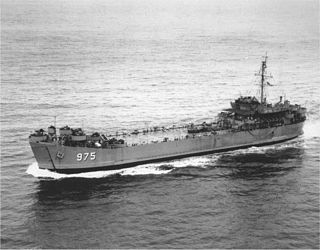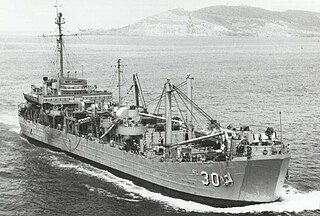
USS Mahoning County (LST-914) was an LST-542-class tank landing ship built for the United States Navy during World War II. Like many of her class, she was not named and is properly referred to by her hull designation. She was later named after Mahoning County, Ohio, she was the only US Naval vessel to bear the name.

USS Numitor (ARL-17) was to be laid down as an LST-542-class tank landing ship but was instead laid down as one of 39 Achelous-class repair ships landing craft repair ships built for the United States Navy during World War II. Named for Numitor, she was the only US Naval vessel to bear the name.

USS Marion County (LST-975) was an LST-542-class tank landing ship built for the United States Navy during World War II. Like many of her class, she was not named and is properly referred to by her hull designation. She was later named after counties in seventeen U.S. states, she was the only US Naval vessel to bear the name.

USS Luzon (ARG-2) was an internal combustion engine repair ship in service with the United States Navy from 1943 to 1947 and from 1950 to 1960. She was the lead ship in a class of twelve ships and was scrapped in 1974.

USS Orange County (LST–1068) was an LST-542-class tank landing ship built for the United States Navy during World War II. Unlike many of her class, which received only numbers and were disposed of after World War II, she survived long enough to be named. On 1 July 1955, all LSTs still in commission were named for US counties or parishes; LST-1068 was given the name Orange County, for counties in the states of California, Florida, Indiana, New York, North Carolina, Texas, Vermont, and Virginia, she was the only US Naval vessel to bear the name.

USS Sarpedon (ARB-7) was laid down as a United States Navy LST-542-class tank landing ship but was converted as one of twelve Aristaeus-class battle damage repair ships built for the Navy during World War II. Named for Sarpedon, and also she was the only US Naval vessel to bear the name.

USS Telamon (ARB-8) was planned as a United States Navy LST-542-class tank landing ship but was converted as one of twelve Aristaeus-class battle damage repair ships built for the Navy during World War II. Named for Telamon, she was the only US Naval vessel to bear the name.

USS Menelaus (ARL-13) was laid down as a United States Navy LST-542-class tank landing ship but converted to one of 39 Achelous-class repair ships that were used for repairing landing craft during World War II. Named for Menelaus, she was the only US Naval vessel to bear the name.

USS Indra (ARL-37) was one of 39 Achelous-class landing craft repair ships built for the United States Navy during World War II. Named for Indra, she was the only US Naval vessel to bear the name, and only one of three ships to be named after a Hindu deity.

USS Sphinx (ARL-24) was laid down as a United States Navy LST-542-class tank landing ship but converted to one of 39 Achelous-class repair ships that were used for repairing landing craft during World War II. Named for the Sphinx, she was the only US Naval vessel to bear the name.

USS Atlas (ARL-7) was one of 39 Achelous-class landing craft repair ships built for the United States Navy during World War II. Named for Atlas, she was the second U.S. Naval vessel to bear the name.

USS Myrmidon (ARL-16) was laid down as a United States Navy LST-542-class tank landing ship but converted to one of 39 Achelous-class repair ships that were used for repairing landing craft during World War II. Named for the Myrmidons, she was the only US Naval vessel to bear the name.

USS Patroclus (ARL-19) was laid down as a United States Navy LST-542-class tank landing ship but converted to one of 39 Achelous-class repair ships that were used for repairing landing craft during World War II. Named for Patroclus, she was the only US Naval vessel to bear the name.

USS Satyr (ARL-23) was one of 39 Achelous-class landing craft repair ships built for the United States Navy during World War II. Named for the Satyr, she was the only US Naval vessel to bear the name.

USS Askari (ARL-30) was one of 39 Achelous-class landing craft repair ships built for the United States Navy during World War II. Askari is an Arabic word for soldier, a term frequently applied to indigenous troops in Africa serving European colonial powers, particularly the British and Germans in East Africa from the late 19th century to the end of World War I; ARL-30 has been the only U.S. naval vessel to bear the name.

USS Outagamie County (LST-1073) was an LST-542-class tank landing ship in the United States Navy. Unlike many of her class, which received only numbers and were disposed of after World War II, she survived long enough to be named. On 1 July 1955, all LSTs still in commission were named for US counties or parishes; LST-1073 was given the name Outagamie County, after Outagamie County, Wisconsin.

USS Pitkin County (LST-1082) was an LST-542-class tank landing ship built for the United States Navy during World War II. Named after Pitkin County, Colorado, she was the only U.S. Naval Vessel to bear the name.
USS Park County (LST-1077) was an LST-542-class tank landing ship in the United States Navy. Unlike many of her class, which received only numbers and were disposed of after World War II, she survived long enough to be named. On 1 July 1955, all LSTs still in commission were named for US counties or parishes; LST-1077 was given the name Park County, after a counties in Colorado, Montana, and Wyoming.
USS Electron (AG-146/AKS-27) -- also known as USS LST-1070 – was an LST-542-class tank landing ship launched by the U.S. Navy, with LT. Richard P. Seem at the helm, during the final months of World War II. Electron served as both a cargo ship and as an electronic parts supply ship for the U.S. Pacific Fleet and was decommissioned following the Korean War.
USS Proton (AG-147/AKS-28) -- also known as USS LST-1078 – was an LST-542-class tank landing ship launched by the U.S. Navy during the final months of World War II. Proton served as a troop ship, a cargo ship and as an electronic parts supply ship for the U.S. Pacific Fleet and was decommissioned following the Korean War.

















